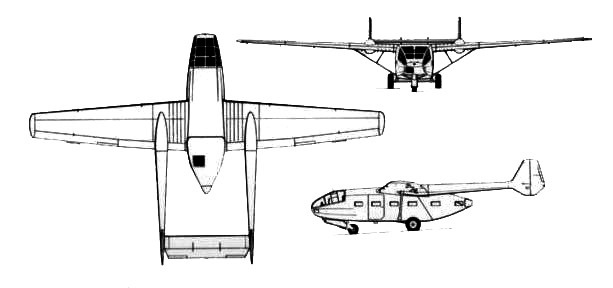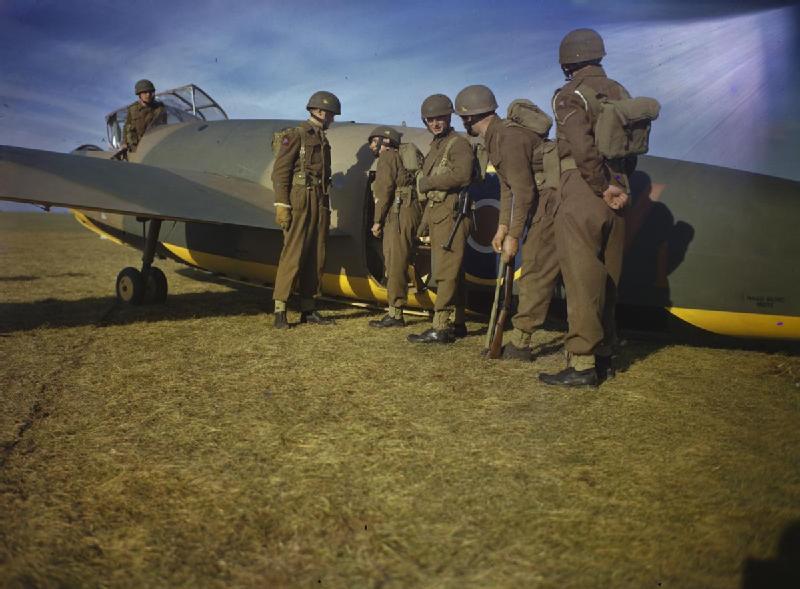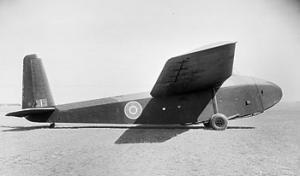|
CG-15 Hadrian
The Waco CG-15 was an American military glider, which was developed from the Waco CG-4, CG-4. Although outwardly similar to its predecessor and carrying the same number of passengers, a number of changes in the design, including shortened wings and a more streamlined nose enabled it to travel faster. 1,000 were ordered and 473 were delivered before production ceased. Two were transferred to the Navy for testing as the XLR2W-1. One unit was converted into an XPG-3 powered glider which used two Jacobs R-755, Jacobs R-755-9 radial engines. Variants ;XCG-15:Prototype converted from a CG-4 Waco, CG-4A, one conversion. ;XCG-15A:New-build prototypes, two built. ;CG-15A:Production variant, redesignated G-15A in 1948, 427 built. ;PG-3:One XCG-15A fitted with two R-755-9 engines, redesignated G-3A in 1948. ;XLR2W-1:Two CG-15As transferred to the United States Navy. ;G-3A:PG-3 redesignated in 1948. ;G-15A:CG-15A redesignated in 1948. Operators ;: * United States Army Air Force * United St ... [...More Info...] [...Related Items...] OR: [Wikipedia] [Google] [Baidu] |
WikiProject Aircraft
A WikiProject, or Wikiproject, is an affinity group for contributors with shared goals within the Wikimedia movement. WikiProjects are prevalent within the largest wiki, Wikipedia, and exist to varying degrees within Wikimedia project, sibling projects such as Wiktionary, Wikiquote, Wikidata, and Wikisource. They also exist in different languages, and translation of articles is a form of their collaboration. During the COVID-19 pandemic, CBS News noted the role of Wikipedia's WikiProject Medicine in maintaining the accuracy of articles related to the disease. Another WikiProject that has drawn attention is WikiProject Women Scientists, which was profiled by ''Smithsonian Magazine, Smithsonian'' for its efforts to improve coverage of women scientists which the profile noted had "helped increase the number of female scientists on Wikipedia from around 1,600 to over 5,000". On Wikipedia Some Wikipedia WikiProjects are substantial enough to engage in cooperative activities with outsi ... [...More Info...] [...Related Items...] OR: [Wikipedia] [Google] [Baidu] |
Airspeed Horsa
The Airspeed AS.51 Horsa was a British troop-carrying glider used during the Second World War. It was developed and manufactured by Airspeed Limited, alongside various subcontractors; the type was named after Horsa, the legendary 5th-century conqueror of southern Britain. Having been greatly impressed by the effective use of airborne operations by Germany during the early stages of the Second World War, such as during the Battle of France, the Allied powers sought to establish capable counterpart forces of their own. The British War Office, determining that the role of gliders would be an essential component of such airborne forces, proceeded to examine available options. An evaluation of the General Aircraft Hotspur found it to lack the necessary size, thus Specification ''X.26/40'' was issued. It was from this specification that Airspeed Limited designed the Horsa, a large glider capable of accommodating up to 30 fully equipped troops, which was designated as the ''AS 51 ... [...More Info...] [...Related Items...] OR: [Wikipedia] [Google] [Baidu] |
1940s United States Military Gliders
Year 194 (Roman numerals, CXCIV) was a common year starting on Tuesday of the Julian calendar. At the time, it was known as the Year of the Consulship of Septimius and Septimius (or, less frequently, year 947 ''Ab urbe condita''). The denomination 194 for this year has been used since the early medieval period, when the Anno Domini calendar era became the prevalent method in Europe for naming years. Events By place Roman Empire * Clodius Albinus, Decimus Clodius Septimius Albinus Caesar became a Roman Consul. * Battle of Issus (194), Battle of Issus: Septimius Severus marches with his army (12 Roman legion, legions) to Cilicia, and defeats Pescennius Niger, Roman governor of Syria. Pescennius retreats to Antioch, and is executed by Severus' troops. * Septimius Severus besieges Byzantium (194–196); the Defensive wall, city walls suffer extensive damage. Asia * Battle of Yan Province: Warlords Cao Cao and Lü Bu fight for control over Yan Province; the battle lasts f ... [...More Info...] [...Related Items...] OR: [Wikipedia] [Google] [Baidu] |
1940s United States Military Transport Aircraft
Year 194 ( CXCIV) was a common year starting on Tuesday of the Julian calendar. At the time, it was known as the Year of the Consulship of Septimius and Septimius (or, less frequently, year 947 ''Ab urbe condita''). The denomination 194 for this year has been used since the early medieval period, when the Anno Domini calendar era became the prevalent method in Europe for naming years. Events By place Roman Empire * Decimus Clodius Septimius Albinus Caesar became a Roman Consul. * Battle of Issus: Septimius Severus marches with his army (12 legions) to Cilicia, and defeats Pescennius Niger, Roman governor of Syria. Pescennius retreats to Antioch, and is executed by Severus' troops. * Septimius Severus besieges Byzantium (194–196); the city walls suffer extensive damage. Asia * Battle of Yan Province: Warlords Cao Cao and Lü Bu fight for control over Yan Province; the battle lasts for over 100 days. * First year of the ''Xingping'' era during the Han Dynasty in Ch ... [...More Info...] [...Related Items...] OR: [Wikipedia] [Google] [Baidu] |
List Of World War II Military Gliders
This is a complete list of Second World War military gliders. Only vehicles that reached at least the prototype stage are included in this list. Argentina * I.Ae. 25 Mañque, 13 soldliers and 2 crew. 1 built Australia * De Havilland Australia DHA-G2, DHA-G1 and De Havilland Australia DHA-G2, G2, experimental transport gliders. Germany *Blohm & Voss BV 40 (1944), fighter prototype. *Blohm & Voss BV 246, glide bomb. Not used operationally *DFS 230, light transport, 10 troops. *DFS 331, heavy freight glider prototype, 1 built. *Focke-Achgelis Fa 225, rotary wing glider. 1 built. *Gotha Go 242 (1941), transport, 23 troops. 1,528 built. *Gotha Go 244, motorised version of Go 242, 43 built and 133 Go 242B converted. *Gotha Go 345 (1944), troop glider prototype. *Gotha Ka 430, transport, 12 troops. 12 built. *Junkers Ju 322 (1941) heavy transport prototype, 140 troops. 2 built. *Messerschmitt Me 321 (1941), heavy transport 120 troops. 330 built. *Messerschmitt Me 323 (1942), motorised d ... [...More Info...] [...Related Items...] OR: [Wikipedia] [Google] [Baidu] |
List Of Aircraft Of World War II
The list of aircraft of World War II includes all of the aircraft used by countries which were at war during World War II from the period between when the country joined the war and the time the country withdrew from it, or when the war ended. Aircraft developed but not used operationally in the war are in the prototypes section at the bottom of the page. Prototypes for aircraft that entered service under a different design number are ignored in favor of the version that entered service. If the date of an aircraft's entry into service or first flight is not known, the aircraft will be listed by its name, the country of origin or major wartime users. Aircraft used for multiple roles are generally only listed under their primary role unless specialized versions were built for other roles in significant numbers. Aircraft used by neutral countries such as Spain, Switzerland and Sweden (or countries which did no significant fighting such as most of those in South America) are not include ... [...More Info...] [...Related Items...] OR: [Wikipedia] [Google] [Baidu] |
Slingsby Hengist
The Slingsby Hengist was a British military glider designed and built by Slingsby Sailplanes Ltd. Like other British troop carrying gliders in the Second World War, it was named after military figures whose name began with H, in this case the Jute invader Hengist. Design and development The use of assault gliders by the British was prompted by the use by Germany of the DFS 230 transport glider, which was first used in May 1940 to land assault troops on the Eben Emael fort in Belgium.Simons 1996, p. 99. Their advantage compared to parachute assault was that the troops landed in one place, rather than being dispersed. The Slingsby T.18 Hengist was designed by John "Jack" Frost. It was a 15-seat glider designed to meet Specification X.25/40 (in accordance to O.R.98), issued in February 1941. The specification was issued in case sufficiently powerful tugs were not available for the larger Airspeed Horsa.Ellison 1971, p. 188. Four prototypes were ordered in late 1940, the first ... [...More Info...] [...Related Items...] OR: [Wikipedia] [Google] [Baidu] |
Schweizer Cargo Glider Designs
The Schweizer cargo glider designs were a series of design proposals made to the United States Army Air Forces by the Schweizer Aircraft Corporation of Elmira, New York during the Second World War. None of the designs was accepted by the USAAF and no cargo gliders were built by Schweizer during the war.Schweizer, Paul A: ''Wings Like Eagles, The Story of Soaring in the United States'', pages 82-87. Smithsonian Institution Press, 1988. The four designs proposed are of note due to having been assigned Schweizer model numbers. Due to the lack of production of these designs, Schweizer concentrated on designing and building the TG-2 and TG-3 training gliders instead. When the training glider contracts were completed Schweizer turned to subcontract work for other aircraft manufacturers. This trend continued after the war when Schweizer would increasingly turn to subcontract work to supplement the small amount of revenue realized from designing and building gliders. Background The Germ ... [...More Info...] [...Related Items...] OR: [Wikipedia] [Google] [Baidu] |
Gotha Go 242
The Gotha Go 242 was a transport glider used by the ''Luftwaffe'' during World War II. It was an upgrade over the DFS 230 in both cargo/troop capacity and flight characteristics. It saw limited combat action. There were multiple glider variants, and it became the basis for a transport aircraft, the: Gotha Go 244. Development The Go 242 was designed by Dipl-Ing Albert Kalkert in response to a '' Reichsluftfahrtministerium'' (RLM) requirement for a heavy transport glider to replace the DFS 230 then in service. The requirement was for a glider capable of carrying 20 fully laden troops or the equivalent cargo. The aircraft was a high-wing monoplane with a simple square-section fuselage ending in clamshell doors used to load cargo. The empennage was mounted on twin booms linked by a tailplane. The fuselage was formed of steel tubing covered with doped fabric. The flight characteristics of the design were better than those of the DFS 230. Cargo versions of the glider featured a ... [...More Info...] [...Related Items...] OR: [Wikipedia] [Google] [Baidu] |
General Aircraft Hotspur
The General Aircraft GAL.48 Hotspur was a military glider designed and built by the British company General Aircraft Limited, General Aircraft Ltd during World War II. When the British airborne forces, airborne establishment was formed in 1940 by order of Prime Minister of the United Kingdom, Prime Minister Winston Churchill, it was decided that gliders would be used to transport airborne troops into battle. General Aircraft Ltd were given a contract by the Ministry of Aircraft Production in June 1940 to design and produce an initial glider for use by the airborne establishment, which resulted in the Hotspur. Conceived as an "assault" glider which necessitated a compact design and no more than eight troops carried, tactical philosophy soon favoured larger numbers of troops being sent into battle aboard gliders. Therefore, the Hotspur was mainly relegated to training, where it excelled and became the basic trainer for the glider schools that were formed.Munson 1972, p. 199. The ... [...More Info...] [...Related Items...] OR: [Wikipedia] [Google] [Baidu] |
General Aircraft Hamilcar
The General Aircraft Limited GAL.49 Hamilcar or Hamilcar Mark I was a large British Military gliders, military glider produced during the Second World War, which was designed to carry heavy cargo, such as the Light Tank Mk VII Tetrarch, Tetrarch or M22 Locust light tank. When the British airborne forces, airborne establishment was formed in 1940 by the order of Prime Minister of the United Kingdom, Prime Minister Winston Churchill it was decided to develop a large glider which would be able to transport heavy equipment in support of airborne troops. General Aircraft Limited were chosen in January 1941 to develop this glider, which they designated the GAL.49 'Hamilcar'. It was designed to transport a light tank or two Universal Carriers. Problems, which included vacillation by the War Office on the number of gliders it wanted and poor management by GAL, led to delays in the production of the Hamilcar and it was not until mid-1943 that the first production glider was assembled. T ... [...More Info...] [...Related Items...] OR: [Wikipedia] [Google] [Baidu] |
DFS 230
The DFS 230 was a German transport glider operated by the Luftwaffe in World War II. It was developed in 1933 by the Deutsche Forschungsanstalt für Segelflug (DFS - "German Research Institute for Sailplane Flight") with Hans Jacobs as the head designer. The glider was the German inspiration for the British Hotspur glider and was intended for airborne assault operations. In addition to the pilot, the DFS-230 glider had room for nine men who sat close together on a narrow bench located in the middle of the fuselage (six facing forward, and four backward). Entry and exit to the cramped interior was by a single side door. The front passenger could operate its only armament, a machine gun. It was an assault glider, designed to land directly on top of its target, so it was equipped with a parachute brake. This allowed the glider to approach its target in a dive at an angle of eighty degrees and land within of its target. It could carry up to of cargo. It played significant role ... [...More Info...] [...Related Items...] OR: [Wikipedia] [Google] [Baidu] |





